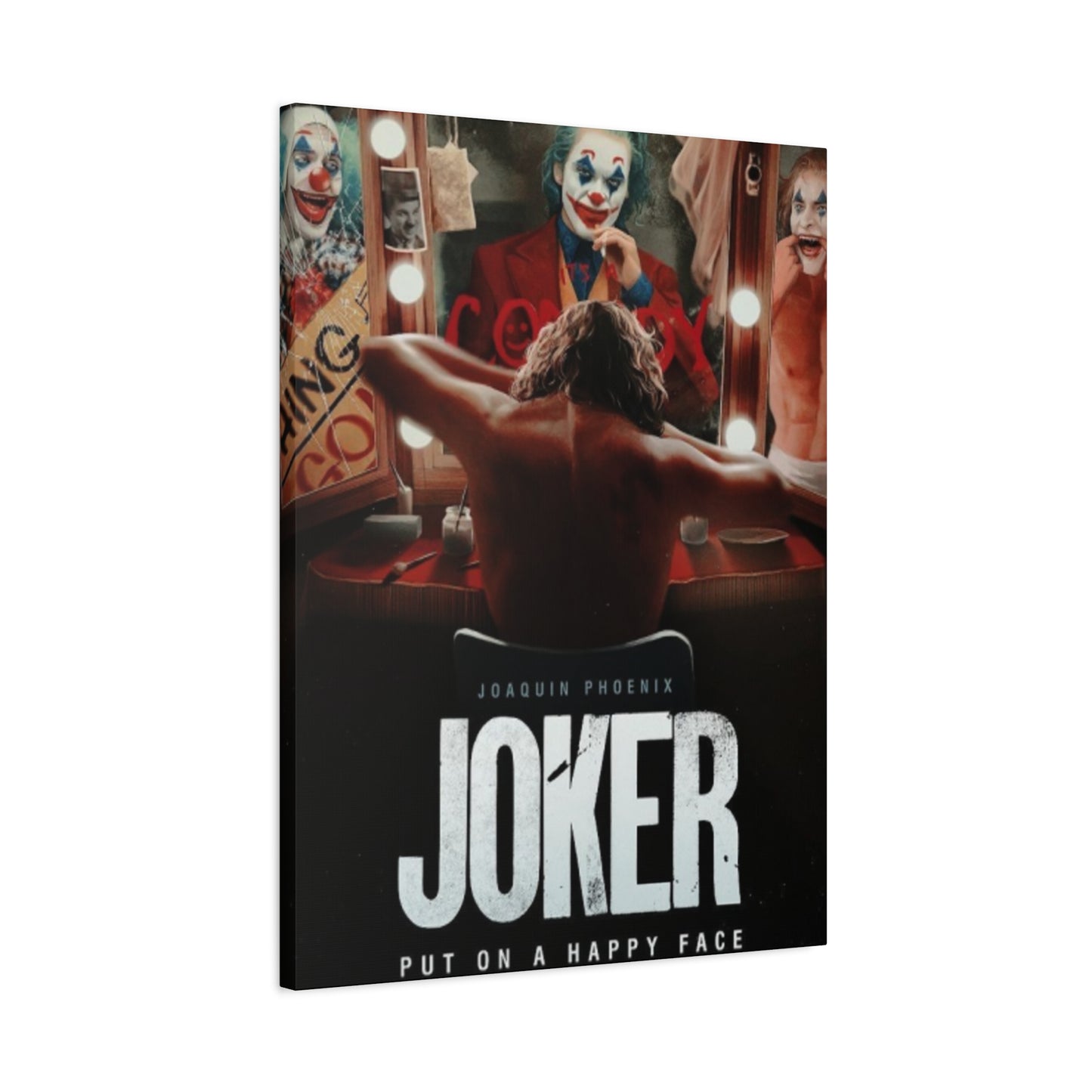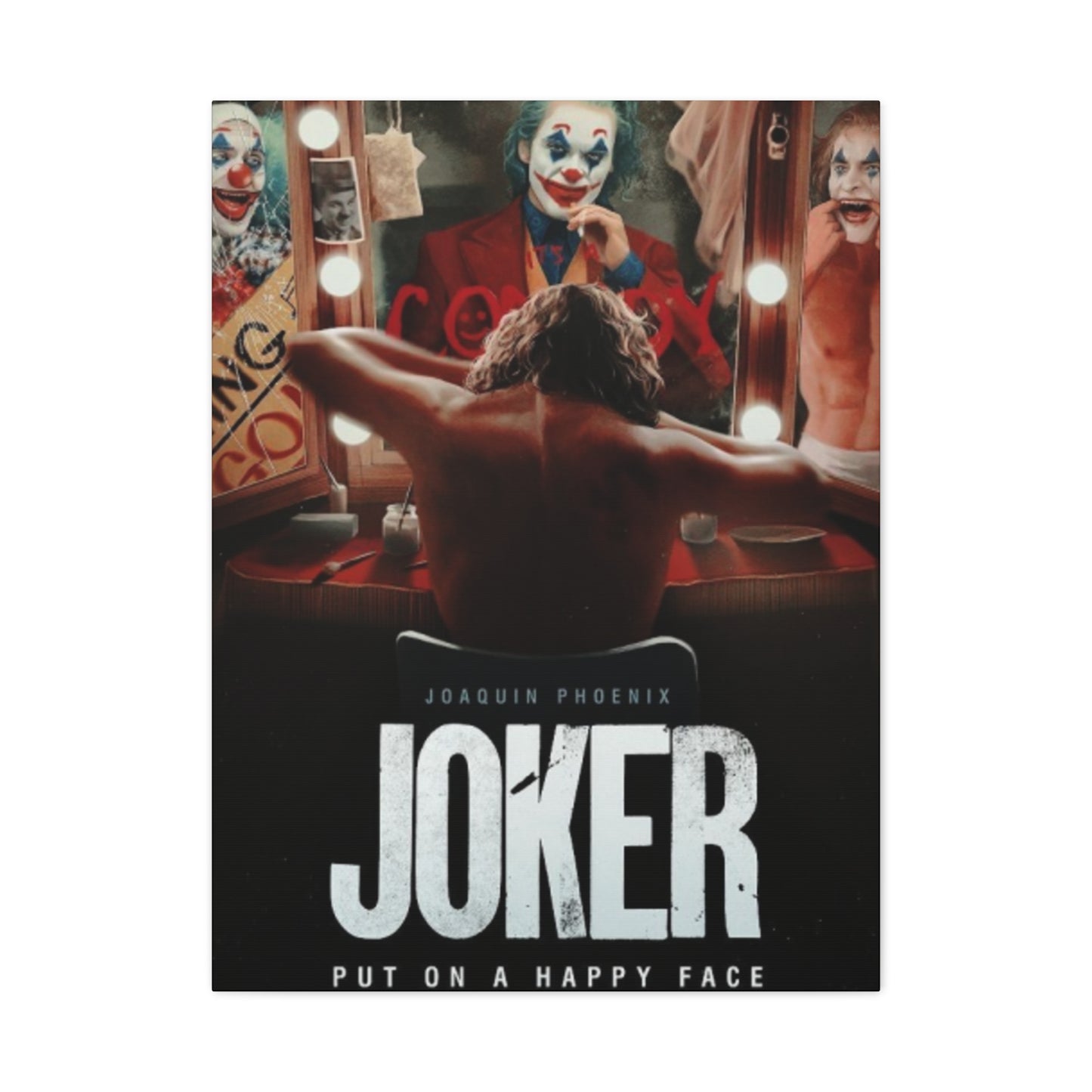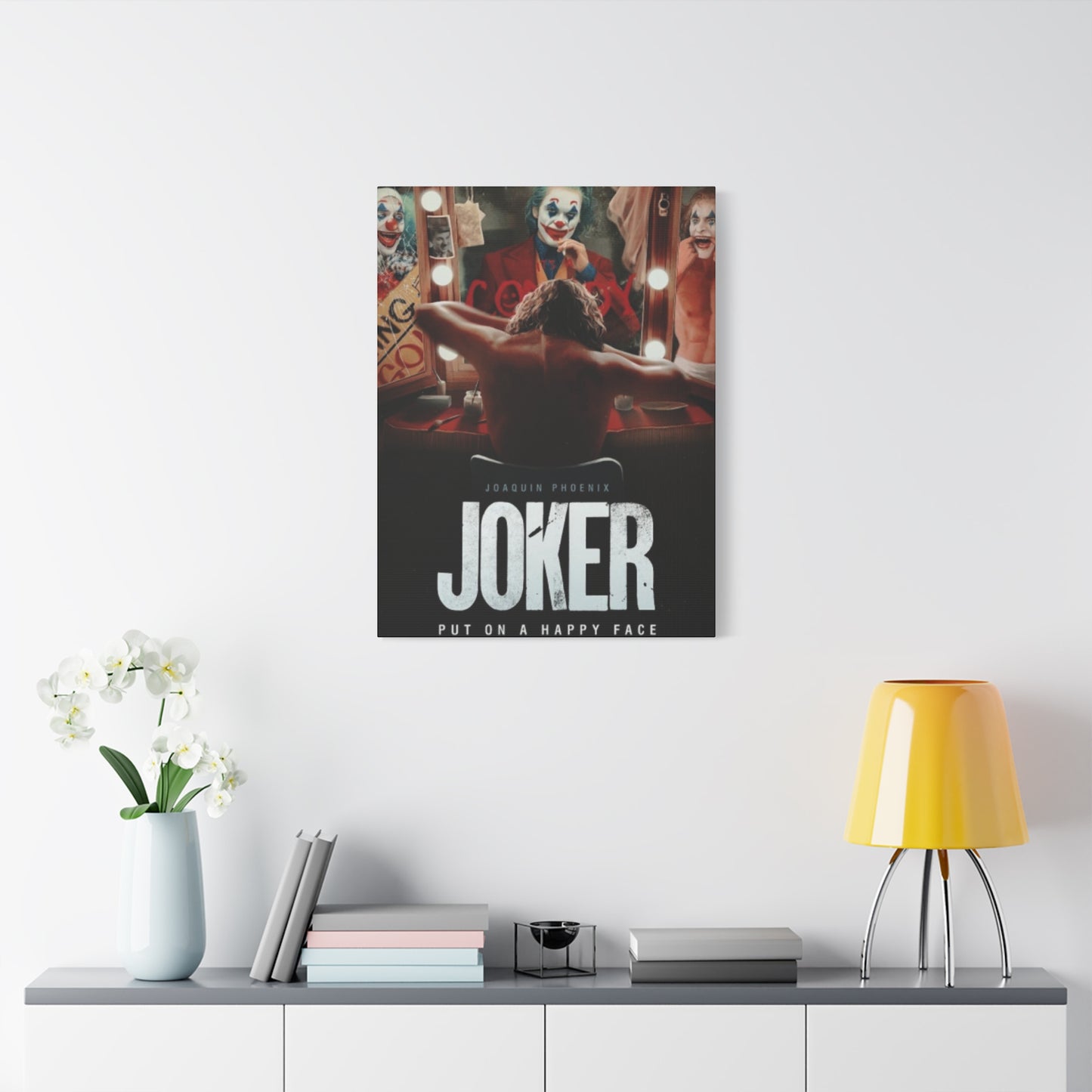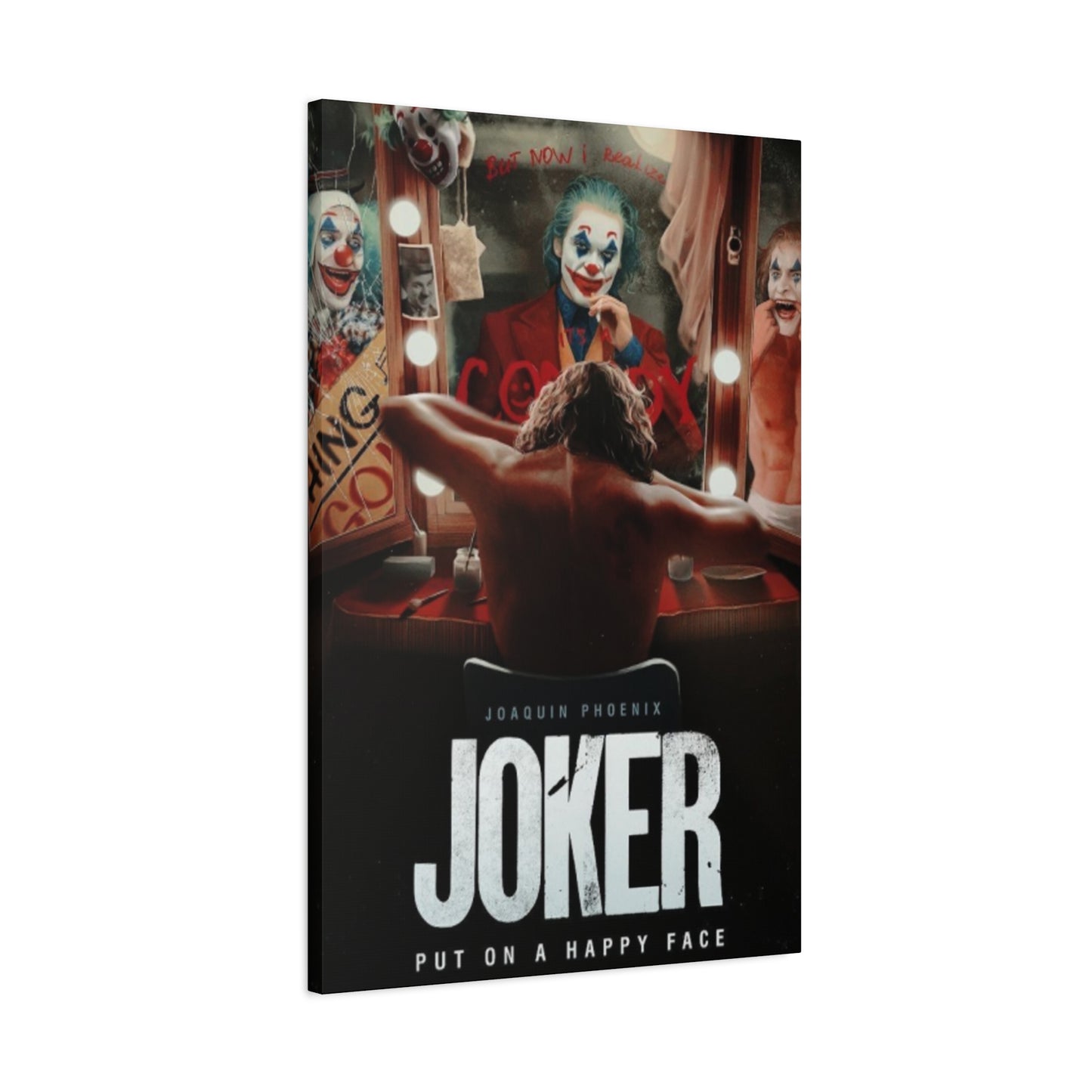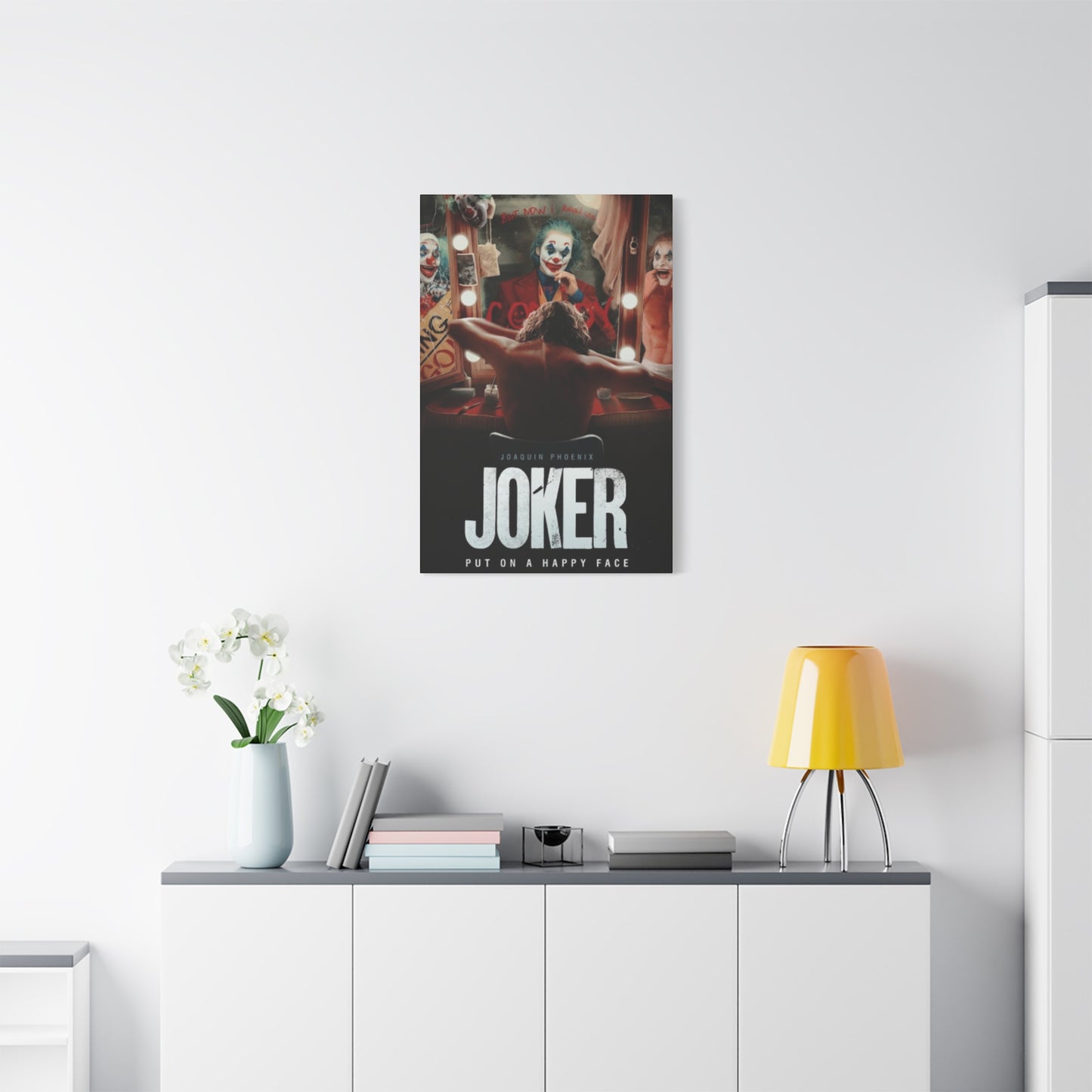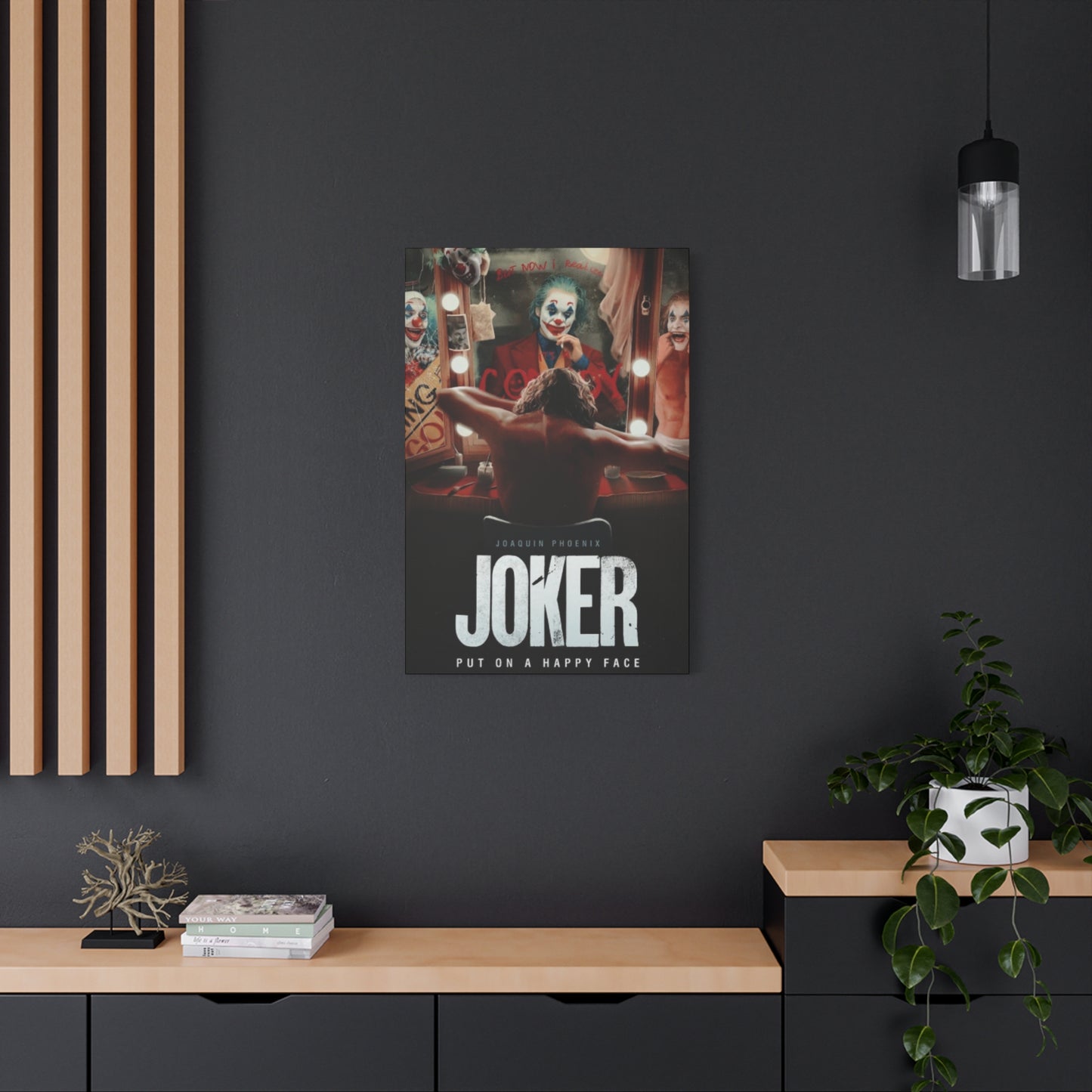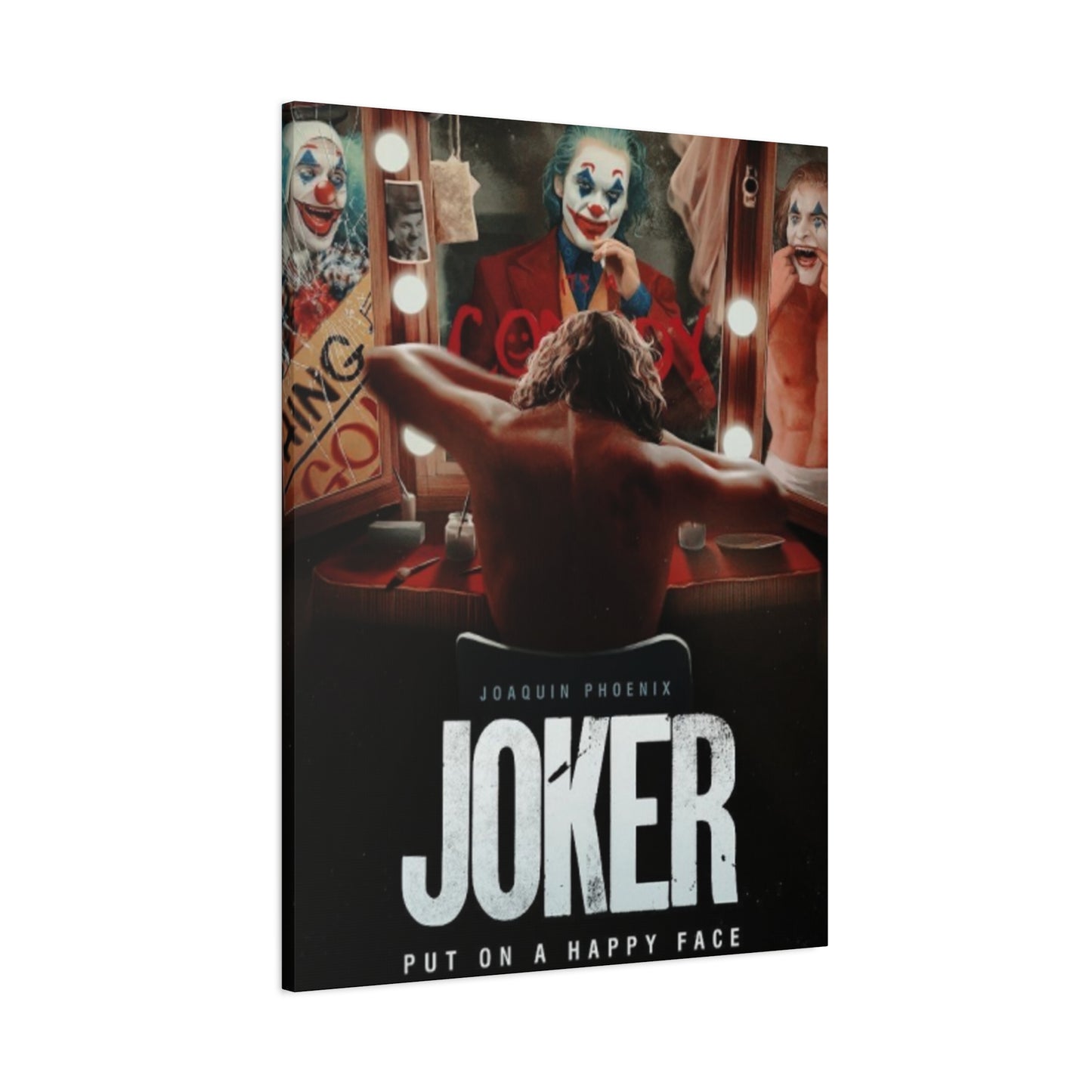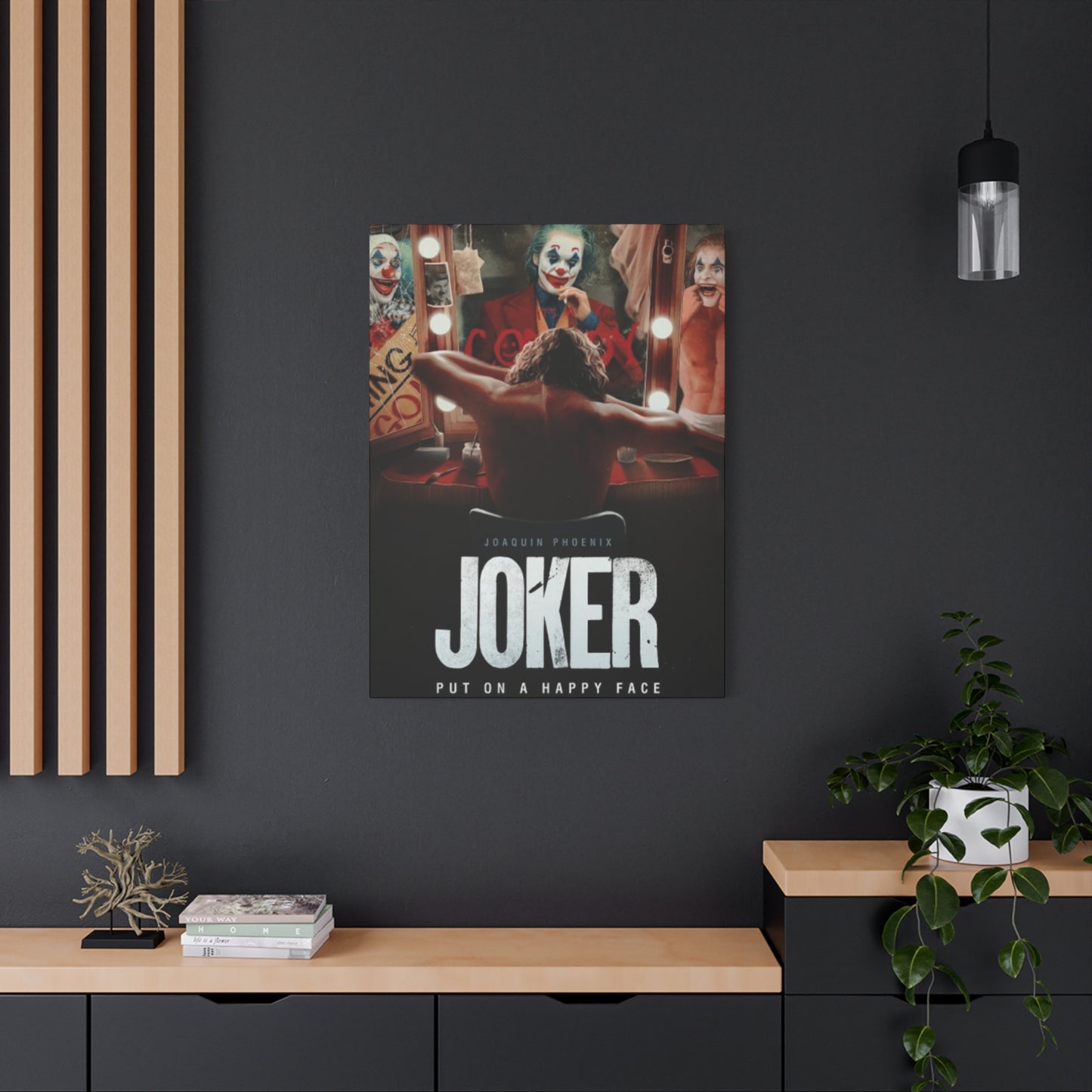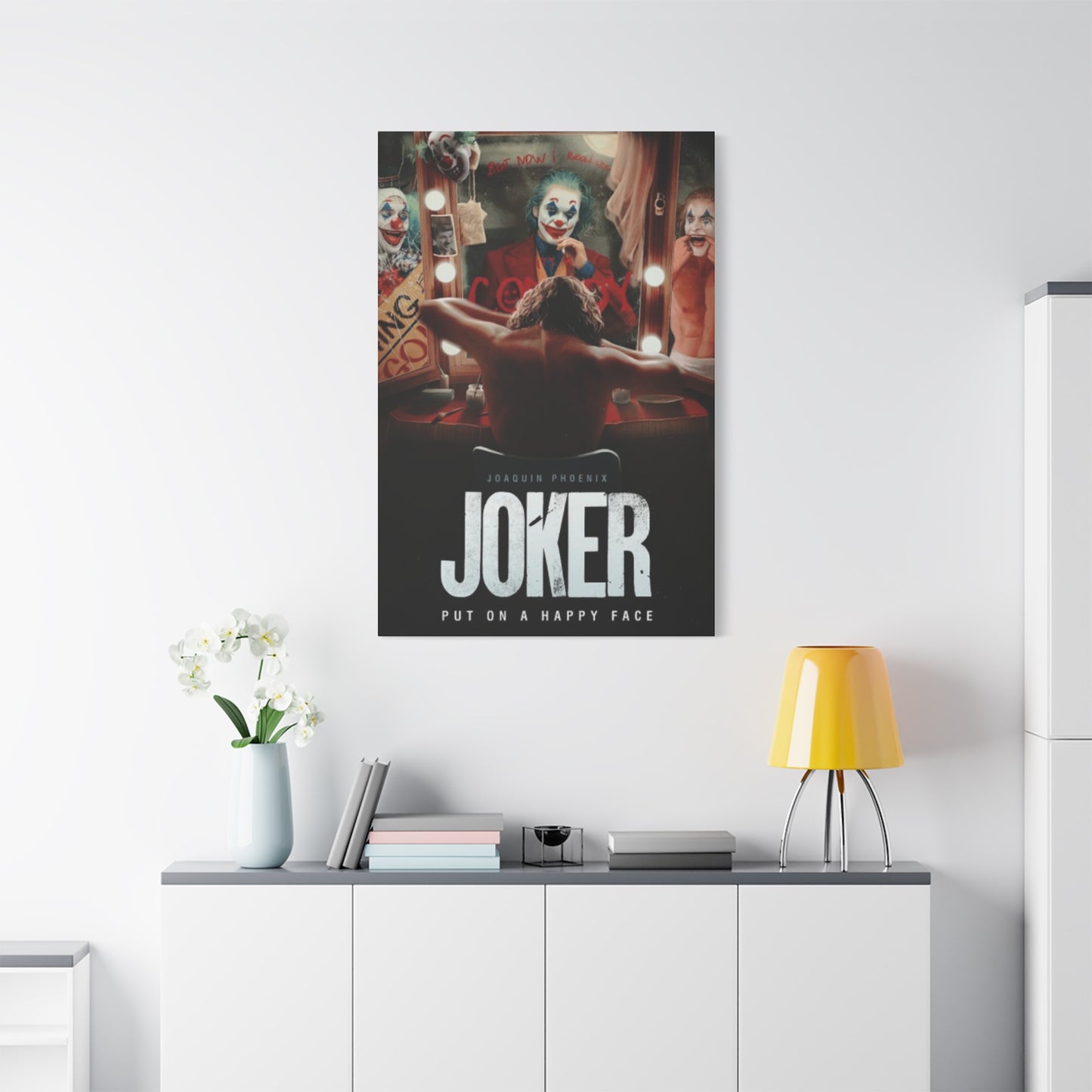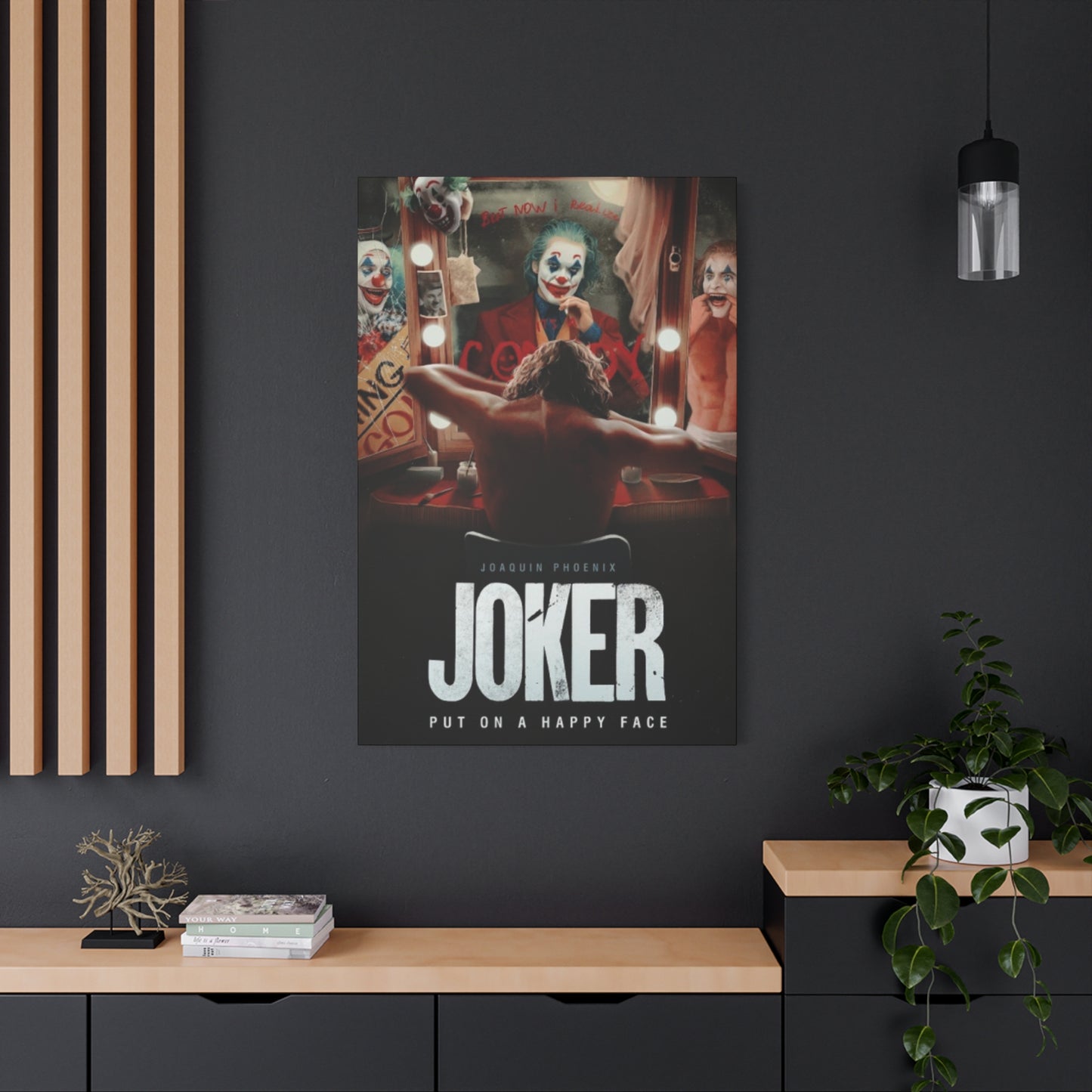The Complete Guide to Joker Horror Movie Poster Wall Art: Transform Your Space with Iconic Villain Imagery
The fascination with villain-themed decoration has experienced tremendous growth over recent years, with the clown prince of crime emerging as one of the most sought-after subjects for interior design enthusiasts. This character represents more than just a comic book antagonist; he embodies chaos, unpredictability, and a complex psychological profile that resonates with audiences worldwide. When individuals choose to incorporate these darker aesthetics into their living spaces, they're making a bold statement about their appreciation for complex storytelling and artistic expression.
The psychological appeal of displaying such imagery stems from humanity's long-standing fascination with the duality of human nature. The character's transformation from various iterations across decades provides a rich tapestry of visual interpretations, each offering unique artistic merit. From the golden age of comics to modern cinematic reimaginations, every version brings distinct visual elements that translate beautifully into wall decoration. Collectors and enthusiasts find themselves drawn to these pieces because they represent a convergence of pop culture history, artistic achievement, and personal expression.
Modern home decoration has evolved beyond simple color coordination and furniture placement. Today's homeowners seek pieces that tell stories, provoke thought, and create conversation. The selection of villain-themed artwork serves these purposes exceptionally well, particularly when the subject matter carries the weight of cultural significance that this particular character possesses. The visual impact of these pieces can transform an ordinary room into a space that reflects personality, interests, and a willingness to embrace unconventional aesthetic choices.
The Evolution of Villain Representation in Visual Media
Throughout cinematic history, the portrayal of this iconic antagonist has undergone remarkable transformations, each leaving an indelible mark on popular culture. The earliest representations in printed media established foundational visual elements that would persist through decades: the distinctive color palette, the unsettling grin, and the aura of unpredictability. These core elements have been reinterpreted countless times, yet they maintain a consistent recognizability that makes them ideal subjects for artistic reproduction.
The transition from page to screen brought new dimensions to the character's visual presentation. Each actor who embodied this role contributed unique interpretations that expanded the visual vocabulary associated with the character. These cinematic interpretations have provided artists with an extensive library of source material, resulting in poster designs that capture specific moments, expressions, and moods from various performances. The diversity of these representations ensures that collectors can find pieces that align with their particular preferences, whether they favor classic interpretations or contemporary reimaginations.
The horror movie aesthetic specifically has influenced many artistic interpretations of this character, emphasizing the unsettling and macabre aspects of his persona. This approach highlights the character's capacity to embody terror and psychological instability, creating visuals that are simultaneously captivating and disturbing. Artists working in this genre often employ dramatic lighting, intense color contrasts, and exaggerated features to amplify the horror elements, resulting in pieces that command attention and create lasting impressions on viewers.
Exploring Different Artistic Styles in Villain Poster Design
The realm of villain-themed poster art encompasses an impressive variety of artistic styles, each offering distinct visual experiences. Photorealistic representations aim to capture the character as he appears in film, preserving the details of makeup, costume, and expression with meticulous accuracy. These pieces appeal to collectors who want to bring the cinematic experience directly into their homes, serving as reminders of memorable performances and iconic scenes. The technical skill required to produce such realistic renderings adds to their value and appeal.
Abstract interpretations take a dramatically different approach, deconstructing the character into essential visual elements and reassembling them in innovative ways. These pieces might focus on color symbolism, geometric patterns, or surrealist compositions that evoke the character's chaotic nature without necessarily depicting him literally. Such artwork appeals to those who appreciate conceptual art and prefer decorations that spark interpretation and discussion. The abstract approach allows artists to explore themes of madness, duality, and chaos in visually striking ways that transcend literal representation.
Minimalist designs strip the character down to his most essential visual components, often relying on silhouettes, limited color palettes, and clean lines to convey identity and mood. This style has gained tremendous popularity in contemporary home decoration because it allows the subject matter to complement modern interior design principles without overwhelming a space. A minimalist villain poster can be sophisticated and stylish while still clearly communicating its subject matter to those familiar with the character. These pieces demonstrate that impactful art doesn't require visual complexity to make strong statements.
Selecting the Perfect Size for Your Wall Space
Determining the appropriate dimensions for your artwork requires careful consideration of multiple factors, beginning with the physical characteristics of the intended display location. A large, blank wall can accommodate oversized pieces that serve as dramatic focal points, commanding attention and setting the tone for the entire room. Such statement pieces work particularly well in living rooms, home theaters, or dedicated entertainment spaces where bold decoration enhances the atmosphere. The impact of a properly sized large-format poster cannot be understated; it transforms wall space from empty to engaging.
Medium-sized pieces offer versatility, fitting comfortably in a variety of locations while still maintaining visual presence. These dimensions work well as parts of gallery walls, where multiple pieces combine to create cohesive displays, or as standalone decorations in bedrooms, offices, or hallways. The moderate scale allows the artwork to contribute meaningfully to a room's aesthetic without dominating it entirely, making these sizes ideal for spaces where you want thematic decoration without overwhelming other design elements.
Smaller prints and posters serve specific purposes in home decoration, working beautifully in intimate spaces like bathrooms, closets, or small offices where larger pieces would feel cramped. They also function well as components of larger arrangements, where varied sizes create visual interest and dynamic composition. When selecting sizes, always measure your available wall space and consider the viewing distance; artwork that will be seen primarily from across a room can be larger and bolder, while pieces viewed from closer proximity might benefit from smaller dimensions that allow detailed examination.
Color Schemes and Their Impact on Room Atmosphere
The chromatic choices in villain-themed artwork significantly influence how a piece integrates with existing room decoration and affects overall ambiance. Traditional color associations with this character typically involve purple and green combinations, creating visually striking contrasts that immediately signal the character's identity. These vibrant palettes can energize a space, adding excitement and visual interest to rooms that might otherwise feel mundane. However, the boldness of these colors requires careful consideration of surrounding decor to ensure harmonious integration rather than visual chaos.
Darker color schemes featuring blacks, grays, and deep reds evoke more sinister and horror-oriented aesthetics, perfect for creating atmospheric spaces with dramatic flair. These palettes work exceptionally well in entertainment rooms, gaming spaces, or areas designed for relaxation where mood lighting can enhance the artwork's impact. The subdued nature of darker colors allows them to blend more easily with various interior design styles, from industrial to gothic to contemporary minimalism, making them versatile choices for diverse decorating schemes.
Monochromatic approaches, utilizing single-color spectrums or black-and-white compositions, offer sophisticated alternatives that appeal to those who want thematic artwork without the visual intensity of full-color pieces. These understated options can be surprisingly impactful, using shading, contrast, and composition rather than color variety to create interest. Monochromatic villain posters work beautifully in professional spaces like home offices or in modern, minimalist homes where color palettes are intentionally restricted. The elegance of these pieces demonstrates that powerful imagery doesn't require chromatic complexity.
Material Quality and Printing Techniques for Lasting Appeal
The longevity and visual quality of your artwork depend heavily on the materials and printing methods employed in its production. High-quality poster paper with substantial weight provides durability and prevents common issues like curling, tearing, or deterioration over time. Professional-grade papers often feature coatings that protect against UV exposure, moisture, and general wear, ensuring your investment maintains its appearance for years. When evaluating options, consider paper weight measured in grams per square meter, with heavier weights generally indicating superior quality and durability.
Canvas prints offer distinct advantages for those seeking gallery-quality presentations with enhanced texture and presence. The fabric surface provides depth that paper cannot match, and canvas pieces typically come pre-stretched on wooden frames, eliminating the need for additional framing. This format particularly suits larger pieces and creates a more refined, museum-like appearance that elevates the perceived value of the artwork. Canvas also tends to be more forgiving regarding minor imperfections in wall surfaces, as its texture can create visual interest that draws eyes away from background irregularities.
Metal prints represent the cutting edge of contemporary poster reproduction, offering unprecedented durability, vibrant color reproduction, and unique visual characteristics. The process infuses inks directly into specially coated aluminum surfaces, creating images with remarkable depth, luminosity, and resistance to damage. Metal prints work exceptionally well for villain-themed artwork because the medium's inherent qualities enhance dramatic visuals and create striking presentations. Though typically more expensive than paper or canvas alternatives, metal prints justify their cost through superior longevity and distinctive appearance.
Framing Options to Enhance Visual Impact
The frame you select for your artwork can dramatically alter its presentation and how it integrates with your room's existing aesthetic. Traditional wooden frames bring warmth and classic appeal, with options ranging from ornate carved designs suitable for vintage-style pieces to clean-lined modern frames that complement contemporary artwork. Wood frames offer extensive customization possibilities through various stains, paints, and finishes, allowing precise matching to your home's existing woodwork or furniture. The substantial nature of wooden frames also adds perceived value and seriousness to artwork, signaling that the piece is cherished and thoughtfully displayed.
Metal frames provide sleek, modern alternatives that work beautifully with contemporary interior design schemes. Available in finishes including matte black, brushed silver, gold, and bronze, metal frames can either blend subtly with artwork or create deliberate contrasts that enhance visual impact. The slim profiles typical of metal frames suit minimalist aesthetics while providing robust protection for artwork. For villain-themed horror posters, black metal frames often prove particularly effective, creating sharp boundaries that contain and intensify the artwork's dark energy.
Frameless presentation methods including edge mounting, floating mounts, and direct wall adhesion offer ultra-modern alternatives that maximize focus on the artwork itself. These approaches work exceptionally well with contemporary pieces and in spaces where minimalism is prioritized. Edge-mounted pieces where the poster appears to float slightly away from the wall create intriguing shadow effects and three-dimensionality that enhance visual interest. However, frameless options require more careful installation and typically work best with higher-quality materials that can maintain structural integrity without frame support.
Creating Gallery Walls with Villain Themed Collections
Gallery walls have become increasingly popular as methods for displaying multiple pieces of artwork in cohesive, visually appealing arrangements. When building a villain-themed gallery, consider establishing a unifying element that ties disparate pieces together, whether through consistent color schemes, similar artistic styles, or thematic connections across different portrayals of the character. This underlying consistency allows you to incorporate variety while maintaining visual coherence that prevents the arrangement from appearing chaotic or disorganized.
The physical arrangement of pieces within a gallery wall requires thoughtful planning to achieve balance and visual flow. Begin by laying out your pieces on the floor to experiment with different configurations before committing to wall placement. Consider creating a template using paper cutouts matching your artwork dimensions, which you can temporarily attach to the wall to visualize the final arrangement without creating unnecessary holes. Aim for relatively consistent spacing between pieces, typically two to three inches, which allows each item to maintain its individuality while contributing to the collective display.
Mixing different sizes within your gallery wall creates dynamic visual interest and prevents monotony. A common approach involves centering the arrangement around one or two larger statement pieces, with smaller items surrounding and supporting them. This hierarchy guides viewer attention while ensuring the overall display doesn't feel static or predictable. Remember that gallery walls can evolve over time; starting with a core collection and gradually adding pieces allows your display to grow organically and prevents the pressure of creating a perfect arrangement immediately.
Incorporating Villain Aesthetics into Different Room Types
Living rooms represent ideal spaces for prominent villain-themed artwork, as these common areas naturally lend themselves to conversation-starting decoration. A large-scale horror poster above a couch or fireplace establishes immediate atmosphere and signals to guests that they've entered a space with distinct personality. When incorporating such artwork into living areas, consider how the piece will be viewed during different activities; artwork that creates ambiance during movie watching might have different requirements than pieces meant to complement reading or conversation areas.
Bedroom decoration with darker themed artwork requires balancing atmospheric impact with the room's primary function as a restful retreat. While many people find comfort in surrounding themselves with imagery they love, consider the psychological effects of having intense, horror-oriented visuals as the last thing you see before sleep and the first thing visible upon waking. Strategic placement can address these concerns; positioning artwork on walls that aren't directly in the line of sight from the bed allows you to enjoy the pieces without them dominating your most intimate moments of rest.
Home offices and creative workspaces benefit tremendously from personality-driven decoration that inspires and energizes. Villain-themed artwork in professional spaces demonstrates confidence and can serve as conversation pieces during video calls, revealing aspects of your personality to colleagues and clients. The character's association with creativity, thinking outside conventional boundaries, and challenging established norms can provide daily inspiration for innovative thinking and problem-solving. Choose pieces that energize rather than disturb, focusing on artistic interpretations that emphasize creativity and complexity rather than pure horror elements.
Lighting Techniques to Maximize Artwork Impact
Proper illumination transforms good artwork into stunning visual statements that command attention and showcase artistic details. Dedicated picture lights mounted directly above or below artwork provide focused illumination that highlights the piece while minimizing glare and creating dramatic shadows that enhance depth perception. These fixtures come in various styles from traditional brass to modern LED strips, allowing selection that complements both artwork and room aesthetics. The directed light from picture lights ensures the artwork remains visible and impactful even in rooms with variable ambient lighting.
Track lighting offers flexible solutions for illuminating multiple pieces or larger artworks, with adjustable heads that can be positioned precisely to achieve optimal lighting angles. This approach works particularly well in rooms featuring gallery walls or multiple villain-themed pieces displayed throughout the space. The ability to adjust individual lights allows fine-tuning of the display as you add or rearrange artwork, maintaining optimal presentation regardless of configuration changes. Modern track systems often include dimming capabilities, enabling adjustment of light intensity to suit different moods and times of day.
Ambient room lighting significantly affects how artwork appears throughout the day and during evening hours. Natural daylight reveals details and colors with unmatched accuracy but changes continuously as the sun moves, meaning artwork can look dramatically different at various times. Evening lighting typically relies on artificial sources that may color-shift artwork depending on bulb temperature; warm-toned bulbs emphasize reds and oranges while cool bulbs enhance blues and purples. Consider how your chosen pieces will appear under your room's typical lighting conditions, and don't hesitate to adjust lighting specifically to optimize artwork presentation.
Protecting Your Investment Through Proper Care and Maintenance
Preserving the quality and appearance of your artwork requires understanding the environmental factors that contribute to deterioration. Direct sunlight poses perhaps the greatest threat, as UV radiation causes inks and papers to fade over time, gradually robbing artwork of its vibrancy and visual impact. Position pieces away from windows receiving strong direct sunlight, or use UV-filtering glass in frames to mitigate exposure. Even indirect sunlight can cause gradual fading, so monitor how light enters your space throughout the day and consider rotating pieces periodically if you have multiple items in your collection.
Humidity control prevents numerous problems including paper warping, adhesive failure, and in extreme cases, mold growth that can irreparably damage artwork. Maintain moderate, consistent humidity levels in rooms housing artwork, ideally between forty and fifty percent relative humidity. This range prevents paper from becoming too dry and brittle or too moist and prone to warping. In particularly humid or dry climates, consider using dehumidifiers or humidifiers to maintain optimal conditions. Climate-controlled storage for pieces not currently displayed ensures they remain in excellent condition until you're ready to rotate them into your active display.
Regular dusting and cleaning maintain visual clarity without causing damage. Use soft, lint-free cloths for framed pieces, gently wiping glass surfaces to remove dust accumulation that can dull appearance over time. For unframed or canvas pieces, use soft brushes designed specifically for artwork to remove dust without abrading surfaces. Avoid household cleaning products which may contain chemicals that damage inks or protective coatings. If artwork becomes significantly soiled, consult professional conservators rather than attempting aggressive cleaning that might cause permanent damage.
The Investment Value of Limited Edition and Signed Prints
Understanding the collectible art market reveals opportunities for acquiring pieces that may appreciate in value while providing aesthetic enjoyment. Limited edition prints, where production is deliberately restricted to specified numbers, create scarcity that can drive desirability and value among collectors. These pieces typically include certificates of authenticity stating edition numbers and total production quantities. Lower edition numbers, particularly those from early in the production run, often carry additional value as they represent the earliest examples of the edition when printing equipment and materials were freshest.
Artist signatures add significant value and authenticity to prints, representing direct connection between creator and artwork. Signed pieces verify that the artist approved the specific print, distinguishing it from mass-produced reproductions lacking artistic oversight. Signatures may appear on the artwork itself, typically in margins, or on separate certificates of authenticity. When acquiring signed pieces, verify signature authenticity through comparison with known examples of the artist's autograph, as forgeries occasionally enter the market, particularly for highly sought-after creators.
Provenance, or the documented history of artwork ownership, substantially affects both authenticity verification and market value. Pieces with clear provenance demonstrating legitimate acquisition and responsible stewardship command premium prices and sell more readily than items with uncertain histories. Maintain records of where and when you acquired artwork, including receipts, certificates, and any correspondence with artists or galleries. This documentation protects your investment and facilitates eventual resale should you choose to part with pieces, while also providing interesting historical context that enhances your connection to the artwork.
Discovering Emerging Artists and Unique Interpretations
The contemporary art world offers tremendous opportunities to discover talented emerging artists creating innovative interpretations of classic characters. Independent artists working outside traditional commercial structures often produce the most creative and boundary-pushing work, unburdened by corporate restrictions or franchise requirements. These creators approach familiar subjects with fresh perspectives, incorporating diverse artistic influences and personal visions that result in truly unique pieces unavailable through mainstream channels. Supporting emerging artists not only adds distinctive items to your collection but also contributes to artistic communities and helps talented creators establish sustainable careers.
Online marketplaces and artist communities provide unprecedented access to global talent, allowing collectors to discover artists from anywhere in the world. These platforms enable direct interaction between artists and collectors, fostering relationships that enrich the acquisition experience beyond simple transactions. Many artists welcome discussions about their work, custom commissions, or variations on existing pieces, providing opportunities for personalized artwork tailored to your specific preferences and space requirements. This collaborative approach creates pieces with additional meaning and connection beyond what mass-produced options can provide.
Art festivals, comic conventions, and gallery exhibitions offer in-person opportunities to discover emerging talent while experiencing artwork physically before purchase. The ability to see pieces in person, examining print quality, color accuracy, and physical presence, provides information that digital images cannot fully convey. These events also facilitate direct conversations with artists about their inspirations, techniques, and future projects, deepening your appreciation for their work. Building relationships with artists you admire can lead to advance access to new releases and opportunities to acquire pieces before they become widely available.
Understanding Copyright and Licensing in Character Based Artwork
The legal landscape surrounding character-based artwork involves complex copyright and trademark considerations that affect both artists and collectors. Intellectual property rights protect character designs, preventing unauthorized commercial reproduction and distribution. However, interpretations vary regarding transformative artwork that reimagines characters in new contexts or styles, with some artistic expressions potentially qualifying as fair use under specific circumstances. As a collector, understanding these nuances helps ensure your acquisitions respect creator rights while supporting artists working within appropriate legal boundaries.
Licensed artwork represents officially sanctioned reproductions authorized by copyright holders, ensuring legal compliance and often providing highest quality source materials and printing standards. These pieces typically cost more than unofficial alternatives but guarantee that appropriate parties received compensation for character usage. Licensed items often include special features like holographic authentication marks, official numbering, and certificates directly linking pieces to rights holders. For collectors concerned about legal and ethical considerations, licensed artwork provides peace of mind alongside quality assurance.
Fan art occupies an interesting position in the copyright landscape, representing artistic expression inspired by beloved characters while technically infringing on intellectual property rights. Copyright holders generally tolerate non-commercial fan art as it demonstrates enthusiasm for properties and can enhance fan communities. However, commercial sales of fan art exist in legal gray areas, with enforcement varying based on rights holders' policies and the specific nature of artwork. Some collectors specifically seek fan art for its creativity and passion, while others prefer officially licensed pieces for their legal clarity and often superior production values.
Custom Commission Options for Personalized Wall Art
Commissioning custom artwork allows you to obtain truly unique pieces tailored precisely to your vision and space requirements. Working with artists to create personalized interpretations of classic characters results in one-of-a-kind items that no other collector possesses. The commission process typically begins with consultations where you describe your vision, reference images, size requirements, and stylistic preferences. Artists then create preliminary sketches for your approval before proceeding to final artwork, ensuring the finished piece meets your expectations while incorporating their artistic expertise.
Custom pieces accommodate specific space requirements and aesthetic preferences that mass-produced options cannot address. If you need artwork in unusual dimensions to fit particular wall spaces, or want color schemes precisely matching your existing decoration, commissions offer solutions. You might request incorporation of specific scenes, expressions, or stylistic elements that resonate personally with you, creating artwork with special meaning beyond generic representations. The collaborative nature of commissions makes the acquisition process more engaging and meaningful, transforming you from passive consumer to active participant in artistic creation.
Pricing for commissioned artwork varies dramatically based on artist experience, reputation, piece complexity, size, and medium. Emerging artists typically charge less than established creators, though their work may be equally skilled and visually impressive. Complex pieces requiring extensive detail, multiple subjects, or innovative techniques command higher prices reflecting the additional labor involved. When commissioning work, discuss pricing clearly upfront, understanding what's included and whether revisions incur additional costs. Many artists require deposits before beginning work, with final payment due upon completion, protecting both parties' interests throughout the commission process.
Digital Versus Physical Artwork Considerations
The digital art revolution has introduced new possibilities for acquiring and displaying artwork through non-fungible tokens and digital files designed for screen display rather than physical printing. Digital artwork offers advantages including perfect reproduction without degradation, easy storage, and simple sharing across platforms. Digital pieces can be displayed on dedicated digital frames or screens throughout your home, with the ability to rotate between multiple artworks using the same physical space. This flexibility appeals to collectors wanting variety without the spatial limitations of physical pieces.
However, physical artwork maintains significant advantages that digital alternatives cannot replicate. The tangible presence of physical pieces creates different psychological experiences than screen-based displays, with textures, materials, and three-dimensionality contributing to aesthetic impact. Physical artwork doesn't require electricity or screens, avoiding concerns about technology failures, obsolescence, or the subtle eye strain associated with prolonged screen viewing. Many collectors find that physical pieces feel more permanent and valuable, representing clearer ownership and investment than digital files.
Hybrid approaches incorporating both digital and physical elements offer compelling compromises that maximize advantages of each format. You might acquire high-resolution digital files of favorite pieces, using them as screensavers or rotating displays on digital frames, while also obtaining physical prints of absolute favorites for permanent wall display. This strategy provides variety and flexibility while ensuring your most cherished pieces exist in tangible forms. Some artists now offer bundled packages including both physical prints and digital files, recognizing that different display formats serve different purposes in collectors' lives.
Building Cohesive Themed Decoration Beyond Wall Art
Extending villain aesthetics beyond wall artwork creates immersive spaces with cohesive thematic identity. Complementary decorative items including throw pillows, blankets, and upholstery featuring related imagery reinforce themes while adding functional comfort to living spaces. These textile elements introduce color coordination and visual consistency that tie rooms together, ensuring wall artwork feels integrated rather than isolated. The tactile nature of textiles adds sensory dimensions beyond visual aesthetics, making themed spaces more engaging and comfortable.
Collectible figures, statues, and models displayed on shelves or in cases create three-dimensional extensions of wall artwork themes. These items provide opportunities for curated displays showcasing different aspects of character history and interpretation. Thoughtfully arranged collections become conversation pieces and visual interest points that complement wall artwork while standing as impressive displays in their own right. Lighting within display cases highlights collectibles dramatically, creating focal points that draw attention and showcase your collection's depth.
Functional items including lamps, clocks, bookends, and storage containers featuring thematic designs integrate character aesthetics into daily life beyond pure decoration. These practical pieces demonstrate commitment to themed environments while serving genuine purposes that justify their presence beyond aesthetics alone. The key to successful themed decoration lies in balancing enough cohesive elements to establish clear identity without overwhelming spaces with excessive branding or imagery. Thoughtful curation ensures themed environments feel intentional and sophisticated rather than cluttered or obsessive.
Seasonal and Temporary Display Rotation Strategies
Rotating artwork seasonally keeps your decoration fresh and allows larger collections to receive display time without permanently dedicating wall space to every piece. Seasonal rotation works particularly well with villain-themed horror artwork, which naturally aligns with autumn and Halloween aesthetics but can feel out of place during spring or summer months. Establishing rotation schedules ensures all pieces receive regular display while preventing visual stagnation that occurs when the same artwork remains unchanged for years.
Proper storage of non-displayed pieces prevents damage and ensures they remain in excellent condition for future rotation. Store artwork flat or upright in climate-controlled spaces, protecting pieces with acid-free tissue paper or archival sleeves that prevent surface scratching and environmental damage. Avoid basements, attics, or garages where temperature and humidity fluctuations accelerate deterioration. Label stored pieces clearly to facilitate easy identification when rotation time arrives, saving time and preventing damage from excessive handling while searching for specific items.
Rotation strategies might also reflect your evolving interests and changing room purposes. A home office might feature different artwork than an entertainment space, suggesting rotation when rooms undergo functional changes. Experimenting with different pieces in various locations helps you discover unexpected combinations and placements that enhance both artwork and spaces. This flexibility keeps your home feeling dynamic and responsive to your changing preferences rather than static and unchanging.
The Role of Online Communities in Collector Culture
Online forums, social media groups, and dedicated communities provide valuable resources for collectors seeking knowledge, recommendations, and connections with fellow enthusiasts. These communities share information about new artists, upcoming releases, quality comparisons between different producers, and display techniques that enhance artwork presentation. Participating in collector communities enriches your hobby beyond mere acquisition, providing social dimensions and shared enthusiasm that deepen engagement and enjoyment.
Community participation offers practical benefits including marketplace insights regarding fair pricing, artist reputations, and potential investment value of specific pieces. Experienced collectors willingly share hard-won knowledge about avoiding low-quality producers, identifying authentic signatures, and recognizing fair pricing versus overpriced items. This collective wisdom helps newer collectors avoid expensive mistakes while accelerating their education about the hobby's nuances. Many communities maintain wikis or pinned resources containing curated information about specific artists, production companies, and collecting strategies.
Showcasing your collection within communities provides validation, constructive feedback, and inspiration for display improvements. Sharing photographs of your displays invites suggestions about lighting, arrangement, and complementary pieces that might enhance your presentations. Seeing others' collections sparks creativity and introduces you to artists or pieces you might not have discovered otherwise. The social recognition within collector communities creates additional meaning beyond personal enjoyment, as fellow enthusiasts appreciate your curation choices and display creativity.
Addressing Common Concerns About Dark Themed Home Decoration
Friends and family members sometimes question decoration choices featuring darker subject matter, particularly villains and horror elements. Addressing these concerns requires confidence in your choices and ability to articulate what draws you to these aesthetics. Explaining appreciation for complex character development, artistic merit, or simply honest enthusiasm for the subject matter helps others understand that your choices reflect genuine interests rather than concerning fascinations. Most people respect passionate interests even if they don't share them, particularly when presented with thoughtful explanations.
Concerns about darker decoration affecting mood or mental state occasionally arise, though evidence suggests home decoration reflects existing preferences rather than creating psychological issues. If artwork genuinely makes you uncomfortable or contributes to negative feelings, that's valuable information about your actual preferences versus what you think you should enjoy. However, most people drawn to darker aesthetics find such artwork comforting, energizing, or simply enjoyable without negative psychological impacts. Trust your instincts about what feels right in your personal spaces.
Balancing darker elements with lighter touches prevents spaces from feeling oppressively dark or one-note. Incorporating varied artwork subjects, lighter color accents, and different aesthetic elements alongside villain-themed pieces creates visual diversity that makes spaces more livable and interesting. This balanced approach demonstrates sophisticated taste rather than obsessive fixation on single subjects. Your home should reflect the full range of your interests and personality, not just one narrow facet, resulting in spaces that feel genuinely personal and welcoming.
Incorporating Three Dimensional Elements into Wall Displays
Moving beyond flat artwork, three-dimensional wall elements add physical depth that creates shadows, catches light differently throughout the day, and provides tactile interest. Layered paper constructions, popular in contemporary wall art, create relief sculptures where foreground elements project forward from background layers, establishing spatial relationships and visual depth. These pieces particularly suit character subjects where iconic elements like playing cards, weapons, or costume details can be isolated and elevated, drawing attention to significant symbolic components while creating dramatic shadow play.
Mixed media assemblages combining printed elements with found objects, sculpted components, or alternative materials create unique artistic statements impossible to reproduce exactly. These one-of-a-kind pieces might incorporate actual playing cards, fabric swatches, metal accents, or other materials relevant to character mythology, creating richly textured works that reward close examination. The investment required for such pieces typically exceeds mass-produced prints, but the resulting uniqueness and artistic complexity justify premium pricing for collectors seeking distinctive additions to their collections.
Sculptural wall hangings and masks provide fully three-dimensional villain representations that project dramatically from walls, creating powerful focal points that photographs cannot adequately capture. These pieces exist at the intersection of sculpture and wall art, designed specifically for vertical display rather than freestanding presentation. High-quality sculptural elements cast from resin, formed from metal, or crafted from papier-mâché offer impressive presence and detail that creates immediate impact. Proper mounting becomes critical with heavier sculptural elements, requiring secure anchoring into wall studs rather than simple picture hanging systems.
The Art of Negative Space in Villain Poster Design
Sophisticated poster design recognizes negative space as an active design element rather than merely empty background. Skilled artists use unmarked areas to create shapes, suggest motion, or establish atmosphere without explicit rendering. In villain artwork, negative space might form silhouettes, create tension through isolation, or provide visual breathing room that prevents compositions from feeling cluttered. Understanding how negative space functions helps collectors appreciate subtle design sophistication that distinguishes masterful work from adequate reproductions.
Minimalist approaches emphasizing negative space create powerful statements through restraint, proving that visual impact doesn't require filling every inch with imagery. A small, carefully positioned figure against vast empty background creates tension and psychological weight through isolation and vulnerability, or alternatively, through implied dominance over space. These designs demonstrate confidence, trusting essential elements to carry complete artistic intent without excessive elaboration. The resulting clarity makes minimalist pieces particularly suitable for modern interiors where visual simplicity aligns with broader aesthetic principles.
Balancing positive and negative space requires careful attention to composition and visual weight distribution. Too much empty space risks pieces feeling incomplete or poorly composed, while insufficient negative space creates claustrophobic, overwhelming visuals. Master artists instinctively understand these balances, creating compositions where every element, including emptiness, serves deliberate purposes. Collectors developing their eyes for quality learn to recognize these subtle balances, distinguishing thoughtfully composed artwork from haphazard arrangements that happen to feature popular subjects.
Thematic Consistency Across Multi-Panel Displays
Diptychs, triptychs, and larger multi-panel arrangements create opportunities for complex narratives and visual progressions impossible within single frames. These formats might show character transformations, contrasting interpretations, or sequential moments from stories, creating dynamic displays that encourage viewer engagement through comparison and narrative construction. The spaces between panels become important design elements, creating rhythm and pacing that guides eye movement across complete compositions.
Selecting or commissioning multi-panel works requires considering how individual segments function both independently and collectively. Each panel should maintain visual integrity as standalone artwork while contributing to larger unified compositions. This dual functionality ensures displays remain visually successful even if panels are temporarily separated or viewed individually in photographs. Color coordination, compositional relationships, and thematic connections across panels create cohesion while allowing each segment distinct identity.
Installation of multi-panel displays demands precision to achieve proper alignment and spacing. Consistent gaps between panels create visual rhythm, while misaligned elements create distracting irregularities that undermine sophisticated compositions. Using templates or professional installation services ensures accurate placement, particularly for large or heavy panels where repositioning after initial mounting proves difficult. The effort invested in precise installation pays dividends through professional appearances that showcase artwork optimally.
The Renaissance of Hand-Pulled Screen Prints and Traditional Techniques
Despite digital printing dominance, traditional screen printing experiences renewed appreciation among collectors valuing handcrafted processes and limited availability. Screen printing's layered inks create unique textural qualities and color depth that digital processes struggle replicating. Each color requires separate screens, with skilled printers mixing custom inks and carefully aligning layers to build complete images. This labor-intensive process naturally limits production quantities while ensuring each print receives individual attention during creation.
The slight variations inherent in hand-pulled prints give each example unique character, distinguishing them from mechanically identical digital reproductions. These variations might involve subtle registration differences, ink density fluctuations, or other minor inconsistencies that paradoxically increase rather than decrease value among collectors who appreciate handmade authenticity. The human element in production creates connections between artists and finished works that automated processes cannot replicate.
Contemporary artists often hybridize approaches, using digital tools for design while executing final prints through traditional methods. This synthesis combines modern design flexibility with traditional production's aesthetic qualities and limited edition authenticity. Collectors particularly value these hybrid pieces as they represent best aspects of both approaches: contemporary sensibilities and design sophistication paired with traditional craftsmanship and physical uniqueness that enhances collectibility.
The Intersection of Street Art Culture and Villain Imagery
Street art aesthetics profoundly influence contemporary villain artwork, with many artists incorporating graffiti techniques, urban contexts, and rebellious attitudes associated with street culture. This fusion creates pieces that feel edgy, contemporary, and connected to living artistic movements rather than purely commercial or nostalgic. Street art-influenced pieces often feature bold colors, graphic elements, and text integration reflecting urban environments where graffiti culture thrives.
Stencil techniques characteristic of street art translate effectively into poster design, creating high-contrast images with strong graphic impact. These approaches emphasize simplified forms and striking silhouettes over detailed rendering, resulting in immediately recognizable imagery that communicates powerfully across distances. The aesthetic democracy of street art, where anyone can create visible public work, resonates with collectors who value artistic authenticity and grassroots creativity over established institutional validation.
Many street artists transition into commercial art markets, bringing authentic urban perspectives and techniques to gallery contexts. Collectors can acquire work from artists with legitimate street credentials, owning pieces connected to broader movements and cultural moments. This connection to living artistic traditions adds cultural significance beyond simple decoration, positioning collections within larger conversations about art, public space, and cultural expression.
Building Relationships with Galleries and Art Dealers
Establishing relationships with galleries specializing in pop culture, villain-themed, or horror artwork provides access to curated selections, expert guidance, and opportunities for pieces unavailable through general marketplaces. Gallery staff possess extensive knowledge about artists, techniques, market trends, and collecting strategies, sharing insights that accelerate collector education. These relationships transform acquisition from impersonal transactions into collaborative processes where experts help clients build meaningful, cohesive collections aligned with personal aesthetics and goals.
Gallery events including openings, artist talks, and collector gatherings provide networking opportunities connecting you with fellow enthusiasts and artists themselves. These social aspects enrich collecting beyond solitary appreciation, creating communities around shared interests. Attending events demonstrates serious engagement with the art form, marking you as committed collector whom galleries notify about special opportunities, new acquisitions, or private sales before general public access.
Many galleries offer services beyond simple sales including custom framing, installation assistance, collection consultation, and even artwork rental programs allowing temporary display before purchase commitment. These value-added services justify gallery premiums over direct artist purchases or auction acquisitions. The comprehensive support galleries provide makes them valuable partners for serious collectors building sophisticated, professionally curated displays.
Understanding Different Villain Interpretations Across Media
The character has been reimagined countless times across comics, television, film, animation, and video games, each medium contributing distinct visual interpretations. Comic book versions span decades of artistic styles from golden age simplicity through modern hyper-detailed rendering, providing comprehensive visual history. Television interpretations brought the character to life in ways static images cannot, establishing performance-based characteristics that influenced subsequent visualizations.
Cinematic portrayals represent perhaps the most influential interpretations, with each major film version redefining public perception and providing rich source material for artwork. These performances emphasize different aspects of the character's psychology and appearance, from theatrical flamboyance to understated menace, creating diverse aesthetic options. Artists creating villain-themed work often draw inspiration from specific cinematic interpretations, producing pieces that capture particular performances while adding personal artistic visions.
Animated versions offer stylistic freedom impossible in live-action, producing designs ranging from child-appropriate to darkly sophisticated. Animation's capacity for exaggeration, dynamic movement, and stylized design creates distinctive visual vocabularies that artists incorporate into their work. Collectors appreciating animated aesthetics can find artwork honoring these interpretations, often combining nostalgic appeal with sophisticated design sensibilities that respect animation as legitimate art form deserving serious appreciation.
Strategies for Acquiring Rare and Difficult to Find Pieces
Rare artwork requires patience, persistence, and strategic approaches to acquisition beyond simply browsing available inventory. Establishing saved searches and alerts across multiple marketplaces ensures notification when desired pieces become available. Many rare items appear briefly before other collectors claim them, making rapid response essential. Automated alerts provide critical timing advantages in competitive collecting markets where hesitation costs opportunities.
Building networks within collector communities provides insider knowledge about upcoming sales, private collections being liquidated, or individuals willing to part with pieces at reasonable prices. The most valuable acquisitions often occur through personal connections rather than public marketplaces, as sellers prefer dealing with known enthusiasts who will appreciate artwork rather than flippers seeking quick profits. Cultivating reputation as serious, passionate collector opens doors to opportunities unavailable through impersonal commercial channels.
Auction houses periodically offer rare pieces from estates or collectors downsizing, providing legitimate opportunities for acquiring items rarely available. Understanding auction dynamics including buyer premiums, bidding strategies, and condition assessment ensures successful participation. While auctions create competitive environments potentially driving prices beyond comfortable limits, they also represent best chances for acquiring genuinely rare items unavailable elsewhere. Disciplined bidding with predetermined maximum prices prevents emotional overspending while allowing competitive pursuit of desired pieces.
The Cultural Significance of Villain Iconography in Society
Villains occupy unique cultural positions as transgressive figures who violate social norms while remaining fictional and therefore safe to engage with. This duality allows exploration of forbidden territories through symbolic proxies, providing psychological outlets for impulses that civilization requires suppressing. The enduring popularity of villain imagery reflects deep human needs to acknowledge and examine darkness rather than pretending it doesn't exist within psyches and societies.
Specific villainous characters achieve iconic status transcending original contexts to become universal symbols recognized across cultures and generations. This character represents chaos, anarchy, and rejection of societal constraints, concepts that resonate globally regardless of specific cultural backgrounds. The visual elements associated with the character become shorthand for these complex ideas, enabling instant communication of sophisticated concepts through simple imagery. This symbolic power makes villain imagery particularly potent as decorative elements that communicate beyond mere aesthetic preferences.
Cultural movements periodically embrace villain aesthetics as statements against conformity, authority, or mainstream values. Displaying villain artwork can signal alignment with countercultural positions, artistic sophistication, or simply refusal to accept sanitized, oversimplified worldviews. These symbolic dimensions add layers of meaning to decoration choices, transforming simple aesthetic preferences into personal statements about identity, values, and philosophical orientations. Understanding these cultural dimensions enriches appreciation for why particular imagery resonates so powerfully.
Conclusion:
The journey into collecting and displaying villain-themed horror artwork represents far more than simple decoration decisions. It reflects a sophisticated understanding of visual culture, appreciation for narrative complexity, and confidence in expressing authentic personal preferences regardless of conventional expectations. Throughout this comprehensive exploration, we have examined countless dimensions of this fascinating intersection between pop culture, artistic expression, and interior design, revealing that seemingly simple choices about wall decoration actually encompass rich territories of meaning, technique, and personal significance.
Your decisions to incorporate this darker aesthetic into your living spaces demonstrate intellectual curiosity about the full spectrum of human experience, including those shadowy territories that polite society often prefers to ignore. The character whose imagery we have discussed throughout this guide represents one of fiction's most psychologically complex creations, embodying themes of chaos, transformation, and the thin boundaries separating sanity from madness. By choosing to engage with these themes through artwork, you participate in humanity's ancient tradition of using visual culture to explore difficult questions and uncomfortable truths that words alone cannot adequately express.
The practical considerations we have covered, from selecting appropriate sizes and framing options to understanding printing techniques and maintaining collections, provide the foundational knowledge necessary for making informed acquisition decisions. Quality matters significantly in artwork that you will live with daily, view repeatedly, and potentially maintain for decades. Investing time in understanding materials, techniques, and preservation methods ensures your collection remains visually impressive and structurally sound throughout its lifespan. The financial dimensions of collecting can be managed responsibly through careful budgeting, strategic acquisition timing, and appreciation for how different price points reflect varying levels of quality, rarity, and artistic achievement.
Beyond technical considerations, the psychological and emotional dimensions of curating personal spaces deserve recognition and validation. Your home represents your primary environment, the backdrop against which daily life unfolds and where you return for rest, creativity, and restoration. Filling this crucial space with imagery that genuinely resonates with you rather than conforming to others' expectations creates environments supporting authenticity and wellbeing. The therapeutic value of surrounding yourself with artwork you love should never be underestimated or dismissed as frivolous or superficial. Environmental psychology clearly demonstrates that physical surroundings significantly impact mood, productivity, and overall life satisfaction.
The social dimensions of collecting create opportunities for connection with like-minded individuals who share your enthusiasms and appreciate your aesthetic choices. Whether through online communities, gallery events, or conversations with visitors to your home, your collection facilitates meaningful interactions around shared interests. These connections enrich life beyond the artwork itself, providing social currency and opportunities for belonging within communities defined by passion rather than circumstance. The relationships formed through shared collecting interests often prove surprisingly durable and meaningful, transcending initial connections around specific artworks to encompass broader friendships and mutual support.
As you continue developing your collection, remember that personal growth and evolving tastes naturally influence what resonates with you aesthetically. The pieces you acquire today tell the story of who you are now, capturing this particular moment in your aesthetic journey. Future acquisitions will reflect ongoing evolution, creating collections that become visual autobiographies documenting interests, experiences, and changes over time. This organic growth process should be embraced rather than resisted, understanding that collections need not remain static but can evolve as you do.

















